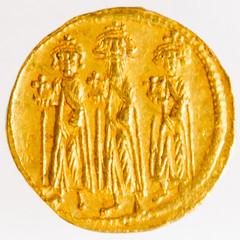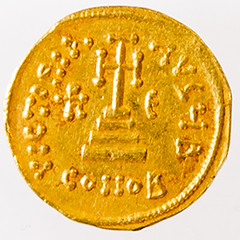
PREV ARTICLE
NEXT ARTICLE
FULL ISSUE
PREV FULL ISSUE
V25 2022 INDEX E-SYLUM ARCHIVE PRINCETON ADDS THEODOTOU BYZANTINE COINSPrinceton University has made another major acquisition for its numismatic collection. Here's the announcement. Thanks to Alan M. Stahl, Curator of Numismatics for passing along the news. Congratulations. -Editor Byzantium, Heraclius, 610-641, gold solidus struck in Constantinople, 632-641, depicting the emperor Heraclius and his two sons. Princeton University Library's (PUL) Numismatic Collection nearly tripled its Byzantine coin collection when it acquired 11,256 Byzantine coins from the estate of Dr. Chris B. Theodotou on March 8, 2022. The acquisition adds to the 5,280 Byzantine coins of the Peter Donald collection, acquired in 2016. Both collections were acquired with support from the Friends of Princeton University Library, while the Seeger Center for Hellenic Studies provided half the funding for these two acquisitions. Together with previous holdings, Princeton now has the largest Byzantine coin collection in the world. The coins, which are primarily issues of the Byzantine Empire between C.E. 500 and 1453, were collected by Theodotou between 1979 and 1987. According to Curator of Numismatics Alan Stahl, Theodotou was both a friend and collecting rival of Donald.
Though the Donald collection added considerable depth to the Library's Numismatics holdings, it lacked any gold coins of the centuries before 1204, which Peter Donald had sold previously. Stahl noted that the Theodotou collection adds 350 gold coins, 305 silver coins, nearly 11,000 bronze coins, 300 lead seals, and 11 coin weights.
Conventional knowledge would suggest that gold is better than silver, but in the case of the Byzantine Empire, silver items are generally rarer. All of the new acquisitions, however, speak to preserving the empire's culture, as few documents or examples of secular material culture remain since its disappearance.
According to Dr. Charlie Barber, Donald Drew Egbert Professor of Art & Archaeology, the Theodotou additions will create opportunities for new and diverse research projects. Stahl mentioned the coins from Heraclius' reign from 610 to 641 C.E. as notable examples of the stories the collection can tell. During his leadership, the Byzantine Empire was attacked by both the Sasanian Persians and the Arab. Adding to his status as a usurper of imperial power, these challenges created a need for him to spend much of his reign restoring legitimacy, a process which is detailed on the coins.
"We value greatly our longstanding partnership with the Princeton University Library," said Dimitri Gondicas, Stanley J. Seeger '52 Director, Seeger Center for Hellenic Studies and Lecturer in the Council of the Humanities and Hellenic Studies. "Central to our mission is to build world-class Hellenic Collections and make them accessible to faculty, students, and visiting scholars. Our contribution towards the acquisition of the Theodotou Collection was made possible by the Stanley J. Seeger Hellenic Fund, in honor of the 40th anniversary of Hellenic Studies at Princeton. In keeping with PUL's mission to facilitate world-class research, the Numismatic Collection has collaborated with the Seeger Center for Hellenic Studies to establish and jointly fund a term position for a scholar who will catalog the Donald and Theodotou collections and create a shared open access platform to display the Byzantine coins held by Princeton and other institutions.
To read the complete article, see:
Wayne Homren, Editor The Numismatic Bibliomania Society is a non-profit organization promoting numismatic literature. See our web site at coinbooks.org. To submit items for publication in The E-Sylum, write to the Editor at this address: whomren@gmail.com To subscribe go to: https://my.binhost.com/lists/listinfo/esylum All Rights Reserved. NBS Home Page Contact the NBS webmaster 
|


